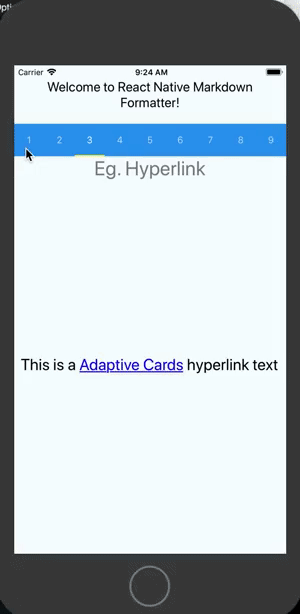A Customizable Markdown Library for rendering Markdown in React Native with native components, working with both iOS & Android.
Custom markdown rules for your application is possible now without any regex learning. Just follow the simple guidelines shown bellow.
Install the node module:
$ yarn add react-native-markdown-formatter
or with npm:
$ npm install --save react-native-markdown-formatter
Then see Usage for futher details
$ cd MarkdownFormatter
$ npm install
$ react-native run-android/run-ios
Tip:
If there is build issue with above command then try running it from Studio/XCode.
- '_italic_' will result in 'italic'.
- '**bold**' will result in 'bold'.
- '[Title](link)' will result in Title.
- '- bullet 1\r - bullet2\r - bulltet 3' will result in following way
. bullet 1 . bullet2 . bullet 3 - '1. numbered 1\r 2. numbered2\n 3. numbered 3' will result in following way
1. numbered 1 2. numbered2 3. numbered 3
To replace or to be added with default config.
-
{ type: 'italic', styles: [], pattern: ['-'], patternType: 'symmetric', groups:1, }The above pattern will render '-italic-' in 'italic'.
-
{ type: 'bullet', styles: [], pattern: ['\\$[\\s]+((.*?)[\\n|\\r](?=\\$[\\s]+)|(.*?)$)'], patternType: 'custom', groups: 1, },The above pattern will convert 'bullet list $ Item 1.1\r$ Item -2.2-\r$ Item 3\r' in following way:
bullet list . Item 1.1 . Item -2.2- . Item 3 -
{ type: 'customHeader1', styles: [styles.header1], pattern: ['**'], patternType: 'symmetric', groups: 1, }, { type: 'customHeader2', styles: [styles.header2], pattern: ['##'], patternType: 'symmetric', groups: 1, },The above pattern will convert "This is a \n**header1** \nand \n##header2## \ntext" in following way:
This is a header1 (header1 style) and header2 (header2 style) textNote: check the demo for better understanding.
-
One can create custom markdown based on project need and render it within text.
-
One can also send the whole regex itself with pattern type custom to have complete control on markdown to apply regex on text and render it.
import RNMarkdownFormatter from 'react-native-markdown-formatter';
let exampleTexts = [
"This is a _Italic_ text",
"This is a **Bold** text",
"This is a [Adaptive Cards](http://adaptivecards.io) hyperlink text",
"This is a **bullet** list - Item **1**.1\r- Item _2.2_\r- Item 3\r ",
"This is a _numbered_ list 1. _Green_\r2. Orange\r3. **Blue**\r",
"This is a custom markdown for bullet list $ Item **1**.1\r$ Item _2.2_\r$ Item 3\r ",
"This is a mixed **_bold/italic_** which also supports **_Type_One** _Type**Two**_ text",
"This is a mixed lists \n**bullet** list - Item **1**.1\r- Item _2.2_\r- Item 3\r and _numbered_ list 1. _Green_\r2. Orange\r3. **Blue**\r",
"This is a #header1# and ##header2## text",
];In your Component's render() method you can then render markdown via JSX e.g.
<View>
<RNMarkdownFormatter
defaultStyles={[]} // or textBlockComputedStyle
numberOfLines={0} // 1(no wrap text) or 0(wrap text)
text={exampleText[5]}
regexArray={[]} // or customMarkdownFormatterRegex
/>
</View>Extra Features: User can also send their custom regex and styles also to apply on text.
//[Optional] user's custom config to be added to default configs
var customMarkdownFormatterRegex = [
{
type: 'bullet', // this will replace the default bullet config with user specified config.
styles: [],
pattern: ['\\$[\\s+](.*?)[\\n|\\r]'],
patternType: 'custom',
groups: 1,
},
{
type: 'italic',
styles: [],
pattern: ['-'],
patternType: 'symmetric',
groups:1,
},
{
type: 'customHeader1',
styles: [styles.header1],
pattern: ['#'],
patternType: 'symmetric',
groups: 1,
},
{
type: 'customHeader2',
styles: [styles.header2],
pattern: ['##'],
patternType: 'symmetric',
groups: 1,
},
];
//[Optional] TextBlock styles
let textBlockComputedStyle = [];
textBlockComputedStyle.push({
fontSize: 24,
margin: 10,
alignItems: 'flex-start'
);NOTE:
// formatter default pattern configs which user does not have to pass to markdown
MD_FORMATTER_CONFIG = [
{
type: 'numbered',
styles: [],
pattern: ["\\d.", '\\r'],
patternType: 'start-end',
groups: 1,
},
{
type: 'bullet',
styles: [],
pattern: ['-', '\\r'],
patternType: 'start-end',
groups: 1,
},
{
type: 'bold',
styles: [styles.boldText],
pattern: ['**'],
patternType: 'symmetric',
groups: 1,
},
{
type: 'italic',
styles: [styles.italicText],
pattern: ['_'],
patternType: 'symmetric',
groups: 1,
},
{
type: 'hyperlink',
styles: [styles.hyperlinkText],
pattern: ['[]()'],
patternType: 'asymmetric',
groups: 2,
},
];- Fork it
- Create your feature branch (
git checkout -b my-new-feature) - Commit your changes (
git commit -am 'Add some feature') - Push to the branch (
git push origin my-new-feature) - Create new Pull Request
Submit bugs and help us verify fixes as they are checked in.




